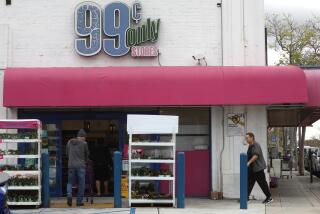Gap’s Old Navy Chain Enlists Legions of Value-Seeking Buyers
- Share via
SAN FRANCISCO — The Old Navy apparel chain’s program during Gap Inc.’s company meeting Thursday included a canine and a salute to cargo shorts--but there was some substance behind the annual dog-and-pony show.
Using a mock talk-show format at Gap’s annual employee meeting, Old Navy’s executives informed their 3,000 Bay Area staff that their chain had exceeded the retailing milestone of $1 billion in annual sales in 1997. It took the Gap chain--the corporate namesake and Old Navy’s big sister--18 years to reach that plateau; Old Navy had done it in its fourth year of existence.
Old Navy helped the San Francisco-based Gap--which also operates the Banana Republic chain--register earnings of $533.9 million for the 12-month period ended Jan. 31--a whopping 18% increase over the same period a year ago.
While the Gap chain floundered during the first half of 1997, industry analysts say the Old Navy chain succeeded by appealing to discount shoppers of all ages, particularly teens, with its casual, all-purpose fashions--jeans, khakis, T-shirts, striped knits and casual dresses. A recent consumer survey by the Zandl Group, a New York-based marketing consultant, indicated that Old Navy is a leader in brand recognition among teens.
“Old Navy is meeting the need for decent casual clothing at modest prices with a name that has developed cachet,” said Kurt Barnard, a New Jersey-based retail economist. “When it comes to the contemporary fashion demands of teenagers, the name has a status.”
Old Navy’s fortunes are rising despite the difficulties in specialty apparel retailing. Sales in this sector improved in 1997 but overall the 1990s have been a tough decade. The problem, say analysts, is that there are too many clothing chains chasing consumers who have declining interest in quick-changing fashion and rising interest in value.
And discounters such as Wal-Mart Stores and off-price chains such as Ross Dress for Less and Marshall’s have seen sales surge while many mid-priced and upscale specialty chains have reorganized under Chapter 11 bankruptcy court protection, including New Jersey-based Petrie Retail Inc.
“Old Navy entered the market at a time when it’s good to be affordable, fashionable and somewhat cool,” said Tom Julian, a New York-based apparel trends analyst. “When I visit their stores I see business executives, moms with kids and teenage girls. Old Navy’s appeal is very broad.”
Analysts say parents are lured by low prices--about 80% of Old Navy’s merchandise is under $25--and youths are attracted by the stylized retro-urban ambience of the stores. Some of the stores have exposed faux ceiling pipes, concrete floors and display bins in the form of life-sized truck replicas.
Old Navy has also generated interest with off-beat marketing and advertising campaigns that include the Rockettes, an animal mascot named Magic the Dog, and print ads that feature no models.
Old Navy’s marketing is directed by Richard Crisman, a senior vice president who received a 1997 Marketer of the Year award from Brandweek magazine. He is one of the three executives who manages Old Navy.
“Our message is, ‘Shopping’s fun and everyone’s welcome,’ ” Crisman said in a recent interview. “Everyone likes to laugh, and we use humor to reach out and be inclusive.”
For example, Old Navy last year launched a TV ad campaign featuring Magic the Dog in different roles, including an Oscar winner and a game show contestant. The commercials promoted Old Navy’s low-priced “Item of the Week” such as ribbed T-shirts for $12.
The ads highlight a merchandise mix selected by Jenny Ming, an executive vice president and a member of Old Navy’s management trio. Last year the chain’s cargo pants--loose-fitting slacks with a large pockets on the leg--were big sellers among men and women.
Ming is now stocking up on cargo shorts for the spring season. Analysts are impressed with other recent offerings. They expect terry-cloth pullovers to be popular with teens and they anticipate that adults will like Old Navy pajamas.
The merchandise is sold by a work force managed by Kevin Lonergan, executive vice president of stores and operations. Lonergan is the third member of the triumvirate that manages Old Navy, a chain with no chief executive. When there is disagreement, the matter is settled by Millard “Mickey” Drexler, president and chief executive of Gap.
It was Drexler who decided to move the company into discount retailing. The growing consumer preference for value became clear in 1993, and the company converted 48 poorly performing Gap stores into Gap Warehouse outlets.
“We were looking for additional opportunities because the majority of apparel in America was selling below the price points of the Gap chain,” Drexler said in an interview this week.
Drexler decided to create a new retail identity and new branded merchandise. The company in 1994 abandoned the Gap Warehouse nameplate and converted 14 of those outlets into Old Navy stores.
Today, there are 282 Old Navy stores in 41 states, including 20 in Southern California. The company plans to open another 110 Old Navy stores in 1998.
Also, the company said it will launch a Banana Republic catalog and open 34 new Banana Republic stores in 1998. Currently, there are 258 Banana Republic stores.
In addition, the retailer is planning to open 174 Gap stores this year--some of them under its GapKids format.
The company currently operates 1,590 stores under various Gap formats.
Sales at the Gap chain sagged during the first half of 1997 partly because of mistakes in inventory selection--offerings such as its poor-selling plaid stretch pants for men--company executives said. Bolstered by a back-to-school advertising campaign--its first in five years--the Gap chain rebounded during the second half of the year, the company said.
Overall, Gap on Thursday reported a 26% increase in fiscal fourth-quarter net income, earning $215.6 million, or 53 cents a diluted share, from $171.2 million, or 41 cents, a year earlier. The results were in line with estimates.
Gap shares were unchanged at $45.94 in New York Stock Exchange trading.
More to Read
Inside the business of entertainment
The Wide Shot brings you news, analysis and insights on everything from streaming wars to production — and what it all means for the future.
You may occasionally receive promotional content from the Los Angeles Times.










